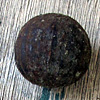The eastern black walnut is native to eastern North America. It grows mostly in riparian zones in the Midwest and east-central United States. It was introduced into Europe in 1629.
The black walnut is a large deciduous tree attaining heights of 30–40 m. The tree is given its name because of the bark color which is grey-black and the dark color of its wood. The bark is deeply furrowed with a rough diamond pattern. The pith inside the twigs is light brown and contains air chambers. Its lifespan is 130 years
The leaves are alternate, 30–60 cm long, odd-pinnate with 15–23 leaflets, with toothed margins and pointed tips. The largest leaflets located in the center, 7–10 cm long and 2–3 cm broad. Terminal leaflet poorly formed or missing. They have a light green color and turn yellow in the fall.
The black walnut blooms in the spring. The male flowers are in drooping catkins 8–10 cm long, the female flowers are terminal, in clusters of two to five, ripening during the autumn into a fruit (nut) with a brownish-green, semifleshy green husk and a brown, corrugated nut. The whole fruit, including the husk, falls in October; the seed is relatively small and very hard. Male and female flowers do not develop at the same time, so in commercial plantations a complementing pollinator variety should be included. The seeds require a cold period before germinating.
The black walnut is cultivated as a forest tree for its high-quality dark-colored, wood. The wood is used to make furniture, flooring, coffins, and rifle stocks. The black walnut is also grown as a specimen ornamental tree in parks and large gardens.
Nuts are harvested by hand from wild trees. About 65% of the annual wild harvest comes from the U.S. state of Missouri. The black walnut kernel is high in unsaturated fat and protein. The black walnut nutmeats are used as an ingredient in ice cream, bakery goods and confections. , and oil is pressed from the seeds.
The husk contains tannins and other dark colored substances that stain hands and clothing. Extracts of the outer, soft part of the drupe are still used as a natural dye for handicrafts. The bark and leaves is especially useful in the treatment of skin diseases,
The roots, nut husks, and leaves of the black walnut secrete a substance into the soil called juglone that is a respiratory inhibitor to some plants. These chemicals are dissolved out of the leaves when it rains and are washed down to the ground below, reducing the growth of plants under the tree.
Written by Amram Eshel






